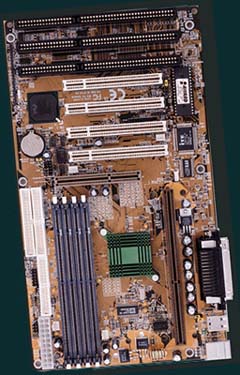Shuttle
HOT-661P
Manufacturer
Shuttle
Retail
Price $100
Expansion
Slot : 4/3/1
The
Shuttle HOT-661P is one of those slim, sexy motherboards that come along
every once in a while. No wasted space on this board- Shuttle have made
good use of every inch, squeezing in 4 DIMM slots together with the old
4 PCI/3 ISA/1 AGP (including 1 shared PCI/ISA slot) configuration. Well,
I suppose 4 PCI slots should satisfy most people, but those of us who want
the extra slot will just have to look elsewhere...no shortage of 5 PCI
slot boards around here. This is also one of those almost-jumperless setups.
That is, you have to adjust jumper settings to override the factory specifications
and tweak settings from the BIOS. Available FSB settings are 66/ 75/ 83/
100/ 103/ 112/ 133MHz; clock multipliers from 1.5x-5.5x.
 |
The
board (actually the Intel BX remake of Shuttleís HOT 661V, which was based
on the VIA Apollo Pro chipset) comes bundled with a driver CD, quick reference
chart and all necessary cables.
As
for overclocking, stability is the name of the game as far as the 661P
is confirmed. There were no stability-related problems at all, which overclockers
in particular will find reassuring. In terms of performance, the 661P lags
a little behind the leaders, but considering that (Weíve heard this one
so many times weíll all probably start muttering it in our sleep) differences
in performance of BX boards is virtually negligible, this is no disgrace.
And when I say it lags behind the leaders,
I
donít mean itís below average,
I mean
itís above average and only just below that final elite level. Nothing
to be disappointed about there. Actually, thereís little to do with this
board that could reasonably disappoint you- itís performance is only a
shade below the best, itís rock-solid stability is highly commendable and
it has most features you could ask for. |
If
at all, the only snag would be the 4/3/1 expansion slot configuration.
With the boom in PCI peripherals, one tends to be somewhat uneasy around
the classic 4/3/1 setup. By no means are 5 PCI slots a requirement now,
of course, but itís no longer unreasonable to assume that you may want
to use five PCI peripherals at some point. Remember, this
is
the computer industry Ėalways keep one eye, if not two, on the evolutionary
horizon. (Donít forget to keep your feet firmly planted on the ground while
you do so, of course. Goes without saying.) Basically it comes down, like
most things do, to personal preference. If you do feel you will eventually
need
the
five slots and donít want to have to upgrade your motherboard at that point,
then set your sights elsewhere. Otherwise, if you feel that 4 PCI slots
are
more than enough for you, this board deserves serious consideration. |

|
|

